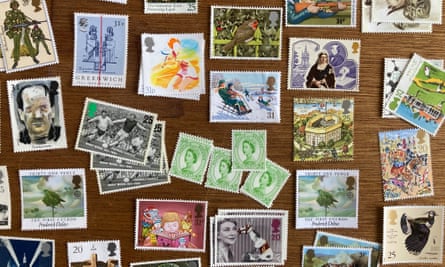After introducing barcodes to our regular sticker stamps in February, Royal Mail has now given us 100 days to use up our old stamps. Come February 2023, only those barcoded will be valid. To swap out any remaining oldies, we will have to fill out a request form and send it, for free, to a depot in Edinburgh.
The ironic loop-the-loop of freeposting postage to receive same-value postage in the post – in order to, in the beleaguered company’s own words, “connect physical stamps to the digital world” – is not lost on me. It’s more than curmudgeonly irritation, though, I feel bewildered. Why does one stamp having the ability to play you Shaun the Sheep videos mean that all those other beauties have to go? Does the Royal Mail not realise how great, how quietly subversive, how steadfast its one defining product has been all these years?
Postage does not expire. You can combine whichever stamps you want to make up the requisite cost for your parcel, no matter how many it takes, or how outdated the denomination. I’ve found there is something awesome about being able to meet an official requirement (the 95p a first-class letter currently costs, say) in alternative ways, not to mention the remarkable sustainability of a system that can accommodate that. For example, postal price hikes are consistently eye-watering – a first-class stamp is now 25p dearer than at the beginning of the pandemic – but if you’ve got an envelope big enough to squeeze on 25 extra 1p stamps, it will get there. Like succulents, stickers, buttons, badges and beads, with stamps it is in the accumulation that the sheer joy resides.
At the beginning of the spring 2020 lockdown, New Yorker writer Rachel Syme repurposed a Secret Santa website to set up a penpal exchange called Penpalooza. She wanted to help people connect. I have always written letters. All the post I received between my 12th birthday and when I moved to London 12 years after that is stashed in boxes in my parents’ attic. And every envelope I’ve opened in the years since then is now stashed in boxes on my own shelves.
So it’s not that I needed Syme’s prompt. But I did get a really good tip from the community of correspondents she convened. Someone mentioned buying old, unfranked stamps in bulk on eBay. I promptly followed suit. I found an eBayer flogging 100 first-class stamps in mint condition. A package turned up with a neat stack of philatelic stock cards (black cards with clear acrylic strips into which you slot your stamps) full of 20p, 25p and 31p stamps. It turned out I hadn’t bought 100 individual first-classers, but the value of the postage in other stamps, the old kind you have to lick and stick.
And so, for the last two years, I have duly tiled over envelopes and cards with an uncommon medley. Leafing through them is a thrill: there are depictions of royal jubilees, biblical translations, sporting milestones and Muffin the Mule. I wasn’t in the UK in 1994, when just one of the 25p stamps in my eBay haul (a robin, a locomotive, Bobby Moore mid-game, the 18th hole at Muirfield golf course, among others) would have been enough to post a letter to my sister. I wasn’t even born in 1971, when the pound was decimalised, council rent cost a fiver a week and a first-class stamp was 3p.

The stamps that Royal Mail now aims to flush out are not of the former variety (special stamps with pictures) but the latter, or what its press materials term “regular” stamps. “They will be very familiar to you,” as the website puts it, “the profile of Her Late Majesty The Queen on a plain coloured background.”
Collectors call these stamps “Decimal Machins”, after the sculpted profile of Queen Elizabeth II by Arnold Machin that they feature, and the 1971 decimalisation of sterling that birthed them. The first issue of these little stamps included halfpenny values and a fetching eyeshadow-hued palette: the 2½p is magenta, the 7½p chestnut.
What this means is that out there in the postal wild are 50 years-worth of tiny scalloped queenly portraits, in dozens of colour-and-value combinations. The largest denomination is the grey-blue £5 – and honestly, who is better off for no longer seeing any of these jostle for space on our post?
It’s a tiny, inconsequential thing, but these envelopes of mine are beautiful – as beautiful, really, as any moment someone takes to sit down and write to you by hand, with a pen, on a piece of paper, or a card. If many people started doing more of that during lockdown, it wasn’t only because we were all so collectively isolated. Time and timeliness took on very different hues, too: the slow and the slight were given more space to breathe. In the absence of openings and launches, we delved into online compendiums of city sounds and figurative watercolours. We noticed things more. We listened.
I never used to know that one particular design of diminutive pre-decimal stamps, which have “postage revenue” inscribed in an oval medallion around a young Queen Elizabeth II, are known as “Wilding definitives”. I love that I do now – the words filed in my brain alongside “phloem bundles” (those strings on your banana) and pomegranate “arils” (what you might call seeds). But that doesn’t make me want to collect stamps in any kind of organised way. It just makes me want to use them more. And I’ve relished the fact that, until now at least, I could.
The old “regulars” aren’t Ulez-busting, diesel-fuelled Routemasters or sodium street lamps. A stamp weighs, at most, two butterflies. It only really occupies two dimensions. And it cannot be franked more than once. It’s as close as you get to holding a moment between your fingers. Don’t let’s lose them.
Source link



